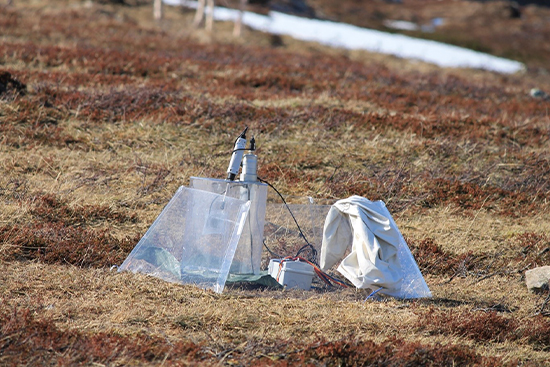An OTC in Kilpisjärvi, Finland, used in warming experiments and carbon analyzers to measure ecosystem carbon fluxes help to understand how tundras will respond to our changing climate. Photo: Anne Tolvanen
In the study, it was observed that the warming of the air and soil, as well as soil drying, increased carbon release from tundra ecosystems
The warming climate shifts the dynamics of tundra environments, according to a new study published in Nature. These changes could transform tundras from carbon sinks into a carbon source, exacerbating the effects of climate change.
A team of over 70 scientists used open-top chambers (OTCs) to experimentally simulate the effects of warming on 28 tundra sites around the world. OTCs basically serve as mini-greenhouses, blocking wind and trapping heat to create local warming.
The warming experiments led to a 1.4°C increase in air temperature and a 0.4°C increase in soil temperature, along with a 1.6% drop in soil moisture. These changes boosted ecosystem respiration by 30% during the growing season, causing more carbon to be released because of increased metabolic activity in soil and plants. The changes persisted for at least 25 years after the start of the experimental warming – which earlier studies hadn’t revealed.
– We knew from earlier studies that we were likely to find an increase in respiration with warming, but we found a remarkable increase – nearly four times greater than previously estimated, though it varied with time and location, says Sybryn Maes of Umeå University, the study’s lead author.
The increase in ecosystem respiration also varied with local soil conditions, such as nitrogen and pH levels. This means that differences in soil conditions and other factors lead to geographic differences in the response – some regions will see more carbon release than others. Understanding the links between soil conditions and respiration in response to warming is important for creating better climate models.
– Our work represents the first assessment of ecosystem respiration response to experimental warming across such a broad environmental gradient in the tundra, incorporating a comprehensive set of environmental drivers, says Professor Ellen Dorrepaal of Umeå University.
 A warming chamber and carbon analyzer to measure ecosystem carbon fluxes help to understand how tundras will respond to our changing climate. Photo: Anne Tolvanen
A warming chamber and carbon analyzer to measure ecosystem carbon fluxes help to understand how tundras will respond to our changing climate. Photo: Anne Tolvanen
The study combines field data from a total of 56 experiments, which offers a broader perspective across the whole tundra area, and helps determining which environmental drivers are the key determinants behind increased ecosystem respiration. Some areas, particularly parts of Siberia and Canada, exhibit greater sensitivity to warming.
The University of Lapland, Arctic Centre, contributed to the study with data from three warming experiments. Current and former researchers Sari Stark, Maria Väisänen, Henni Ylänne, and Eero Myrsky focus on the significance of global changes on ecosystem functions and their climatic feedbacks. Other Finnish partners include the Natural Resource Institute Finland, Aalto University, the University of Helsinki, the University of Eastern Finland, the University of Oulu.
The original article in Nature:
Maes, S. L. et al. (2024). Environmental drivers of increased ecosystem respiration in a warming tundra. NATURE (in press). doi: 10.1038/s41586-024-07274-7
Additional reading:
Tundra flux database - https://www.tundrafluxdatabase.com/
International Tundra Experiment - https://www.gvsu.edu/itex/
Contact:
Dr. Sybryn Maes
Department of Ecology and Environmental Science, Umeå University, Abisko, Sweden Department of Earth and Environmental Sciences, KU Leuven, Leuven, Belgium
Tel: +32 478 50 52 64
E-mail: sybryn.maes@gmail.com
Contact person at the Arctic Centre at the University of Lapland:
University researcher Sari Stark
sari.stark(at)ulapland.fi, +358 40 484 4254